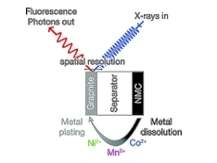X-ray spectroscopy reveals details of capacity fading in Li-ion batteries

The improvement of batteries is one of the key factors in increasing the performance of electric vehicles. To this end, Dr Moniek Tromp of the University of Amsterdam's research priority area Sustainable Chemistry is employing advanced X-ray spectroscopy of battery electrodes under operating conditions. Recently, this has provided new insight in the process responsible for capacity fading of Li-ion batteries. Tromp will present her findings Tuesday 6 December at the Dutch chemistry conference CHAINS 2016 in Veldhoven.
The research, performed in collaboration with the Technical Electrochemistry research group of Prof. Dr Hubert Gasteiger at the Technical University of Munich (Department of Chemistry), has recently been published in Journal of Materials Chemistry A, a high impact journal on materials for energy and sustainability.
Li-ion batteries are widely used in applications such as mobile phones and laptops. They also hold the key to future electromobility, as they have the potential to substantially increase the driving range of electric vehicles. This does however require an increase in their energy density by at least a factor of 2.5. To meet this goal a series of high energy density cathode materials have been developed. Among these manganese-oxide based materials such as LiNiMnCoO (NMC) seem especially promising.
Unfortunately, Li-ion batteries containing these new cathode materials show severe capacity fading. Manganese, nickel and cobalt ions dissolve from the cathode and diffuse towards the anode, where they cause irreversible side reactions that hamper optimal battery performance. In particular, the manganese accumulation on the anode has a detrimental effect.
A detailed mechanistic understanding of the anode side reactions is crucial to reduce or prevent the unwanted side effects and thus optimize battery performance. Key to this all is the determination of the oxidation state of manganese, which determines its reactivity. In recent years, this has been the focus of many research projects, with contradictory results.
The Amsterdam and Munich researchers now deliver a major contribution to this field by performing, for the first time, X-ray spectroscopy under operating conditions. Their results unequivocally show that the migrated manganese at the anode has an oxidation state of +2. The same holds for nickel and cobalt.
This result contradicts many previous observations in which various oxidation states were reported ranging from 0 to +4. The researchers attribute these differences to the fact that all previous results were obtained through ex situ analysis where electrodes are investigated after recovery from a working battery cell. There, the procedures of electrode harvesting and preparation significantly influence the observed oxidation state.
In contrast, the new technique of operando X-ray spectroscopy determines the oxidation states during battery operation. This provides a far more realistic view of the state of the electrode and excludes the influence of electrode preparation procedures such as washing and drying. The research was performed at the SAMBA beamline of the Soleil synchrotron in Saint-Aubin, France, using dedicated X-ray absorption spectroscopy (XAS) electrochemical cells equipped with NMC cathodes and graphite anodes, as previously developed by Tromp.
The operando experiments allowed both the time/voltage and spatially resolved determination of metal concentration and oxidation state of the manganese, nickel and cobalt deposits on the graphite electrode. This also established that NMC shows a strong increase of the metal dissolution rate if the upper cut off potential exceeds 4.6 V.
The research thus provides profound insight in the stability and deactivation of Li-ion batteries equipped with NMC cathodes, establishing the importance of dedicated operando characterization for a comprehensive understanding of the battery processes.
Aiming for more stable battery systems, further research now focusses on the use of different transition metal compositions for the electrode and on the application of electrolyte solvent additives to influence the transition metal dissolution behaviour.
More information: Johannes Wandt et al. Transition metal dissolution and deposition in Li-ion batteries investigated by operando X-ray absorption spectroscopy, J. Mater. Chem. A (2016). DOI: 10.1039/C6TA08865A
Journal information: Journal of Materials Chemistry A
Provided by University of Amsterdam


















